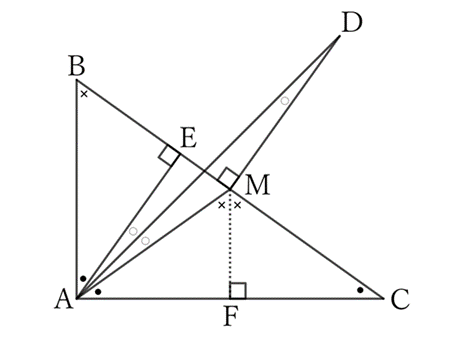If $D$ is the intersection point of the bisector of the right-angled vertex $A$ of a rectangular triangle $ABC$ and the line that passes through the midpoint $M$ of the hypotenuse $BC$ and is perpendicular to $BC$, then
$$MA=MD.$$
$\downarrow$ $\downarrow$ $\downarrow$ $\downarrow$ $\downarrow$
$$ $$Solution

Let the feet of the perpendicular lines drawn from $A$ to $BC$ and from $M$ to $AC$ be $E$ and $F$, respectively.
Since $△MCF≡△MAF$,
$$∠MCF=∠MAF.$$
Since $△ABC \sim △FMC$,
$$∠BAC=∠MFC.$$
Since $△ABC \sim △EBA$,
$$∠BCA \ (=∠MCF) \ =∠BAE.$$
Since $∠BAD=∠CAD=45°$,
$$∠DAE=45°-∠BAE, \qquad ∠DAM=45°-∠MAF, \qquad and \qquad ∠MAF=∠BAE,$$
$$∴ \ ∠DAE=∠DAM.$$
Since $AE∥DM$,
$$∠DAE=∠ADM,$$
$$∴ \ ∠DAM=∠ADM.$$
Therefore, $△MAD$ is an isosceles triangle with $M$ as its vertex, and
$$MA=MD.$$
Reference Teiichiro Sasabe (1976) The Encyclopedia of Geometry (2nd edition), Seikyo-Shinsha, pp.28-29.